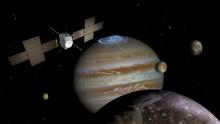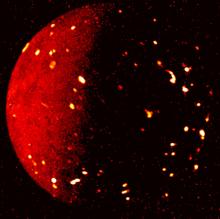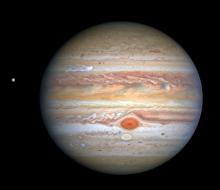Listen to today's episode of StarDate on the web the same day it airs in high-quality streaming audio without any extra ads or announcements. Choose a $8 one-month pass, or listen every day for a year for just $30.
You are here
Moon and Companions
One of the most exotic bodies in the solar system is Io, one of the large moons of Jupiter. It’s covered by hundreds of active volcanoes — more than any other body in the solar system. Their molten rock and volcanic gases make Io look like a scarred apricot.
Io is so active because of a gravitational tug-of-war between Jupiter and its other large moons.
The same side of Io always faces Jupiter, just as the same side of our moon always faces Earth. But as Jupiter’s other moons move past Io, they tug at it, trying to turn it around. That creates tides in Io’s crust. While the highest tides in Earth’s oceans are about 50 feet high, the tides in Io’s solid surface are more than 300 feet high. All of that energy melts some of the rock in Io’s interior, which then pushes its way to the surface.
At the surface, the molten rock bubbles up through cracks in the crust, sometimes building broad volcanic mountains.
Some of the volcanoes produce giant plumes of ash and gas, including the most prominent volcano of them all, known as Pele — a red-and-black bull’s-eye that’s hundreds of miles across. And the plumes extend far into space, creating a fat “doughnut” of gas that encircles Jupiter.
Look for brilliant Jupiter rising below our Moon late this evening, with the bright star Spica close to the lower right of Jupiter. Through binoculars, Io and Jupiter’s three other big moons look like tiny stars arrayed near the giant planet.
Script by Damond Benningfield





